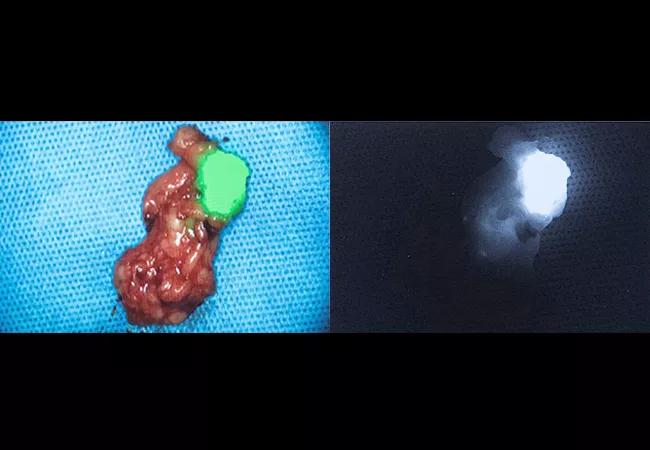Finding sentinel nodes that otherwise go unnoticed

With around 350 lymph nodes in the head and neck, with highly variable anatomical configurations, identifying sentinel nodes in this area is particularly challenging for cancer surgeons. For this reason, biopsy results for patients with head and neck cutaneous and conjunctival melanoma are fraught with more uncertainty than in other regions of the body.
Cleveland Clinic is a non-profit academic medical center. Advertising on our site helps support our mission. We do not endorse non-Cleveland Clinic products or services. Policy
At Cleveland Clinic, however, a surgical oncology team is using indocyanine green (ICG) fluorescence to successfully identify more sentinel nodes. A prospective single-site study led by Brian Gastman, MD, a plastic surgeon who works in cutaneous head and neck surgical oncology, found that a procedure using ICG fluorescence lowered the false negative rate.
In this study, ICG fluorescence, combined with lymphoscintigraphy (radioactive tracer and gamma probe), produced only one false negative, representing a 9.1 percent sentinel node false negative rate (as a percent of all true positives upon follow-up). This compared favorably against an average false negative rate of 22.4 percent found in a review of the literature.
ICG fluorescence has been used in skin, gastric, colon, breast, gynecological and other cancers, but the technology had not yet extended to melanoma, until now.
“While we knew ICG fluorescence improved mapping, this was the first prospective study of whether a combination of ICG-based fluorescence and lymphoscintigraphy reduced false negatives,” says Dr. Gastman.
As recently published in Journal of Surgical Research, 61 patients who underwent surgery with lymphoscintigraphy and ECG-based fluorescence imaging from 2012 to 2015 were prospectively enrolled and tracked up to the date of their last follow-up or date of death. The outcomes included: 10 patients with positive sentinel lymph node biopsies (all true), 50 with a true negative, and one with a false negative (representing 9.1 percent of the patients who had positive diagnoses at the time or upon follow-up).
“These tools have very different mechanisms for identifying sentinel nodes,” says Dr. Gastman. “Using ICG-based fluorescence in conjunction with the radioactive agents enabled us to identify another three nodes that were found to be malignant upon biopsy. Radioactivity aided in detecting the nodal basin, but ICG fluorescence was crucial in identifying the actual nodes.”
To map lymph nodes, the team first injects various agents around the tumor, with technetium-99m sulfur radiocolloid at the epicenter. The ICG fluorescence is then injected into the lymphatic system. Within seconds, areas where the agent has concentrated are detected by a reader and made visible on a screen, indicating the location of the sentinel lymph nodes. Adjusting the brightness setting can help distinguish between a single lymph node and two smaller nodes that are close together, and can assist in depth discrimination. ICG fluorescence is then employed ex vivo to confirm that the node seen in the patient was actually in the specimen removed.
ICG fluorescence does not stain tissues, contains no radiation, has penetration of up to 1 cm deep, and can be visualized up to 10 hours after injection.
“Determining whether the cancer cells have spread and identifying all the sentinel nodes is of utmost importance,” Dr. Gastman explains. “Not only is it prognostically important, but when someone is found to have a little bit of cancer, we now have immunotherapies that can significantly improve their survival chances.
“Our job is to give the pathologist the right lymph nodes. Many times we will get in there and there will be four or five ‘hot’ lymph nodes picked up by lymphoscintigraphy, and we have to hope that the sentinel nodes are within that group.”
This is where this new technology can make the most difference, he notes, by pointing up nodes that might go unnoticed, particularly when there are many to resect.
Dr. Gastman warns that even as our ability to reduce false negatives improves, it is critical to do follow-up imaging for those who have a negative biopsy.
“All of these patients are still at high risk,” he says. “There are many more patients with true negative results who will die from their cancer than those with positive biopsies, because while the proportion of the negatives who have distant metastases is lower, the sheer numbers are much higher.”
Even with this new aid for better identifying cancer in lymph nodes, cells can elude detection by traveling outside the lymphatics or traveling very slowly, not having found their way to the lymph nodes at the time of testing.
While this interim analysis demonstrates ICG fluorescence as a reliable tool, Dr. Gastman’s team is working to generate more data for research.
“We need a larger ‘n’ with similar results before this technology will become standard practice,” he says.

An underdiagnosed condition in patients with cancer

Study demonstrates superior visualization of occult primary lesions

New device offers greater tumor control for malignant liver lesions

Cleveland Clinic researchers discover what drives – and what may halt – virus-induced cancer

First-ever U.S. population-level retrospective analysis reveals many patients with systemic mastocytosis need faster intervention

New program provides prehabilitation and rehabilitation services to help patients with cancer maintain and regain function

First-of-its-kind research investigates the viability of standard screening to reduce the burden of late-stage cancer diagnoses

Global R&D efforts expanding first-line and relapse therapy options for patients